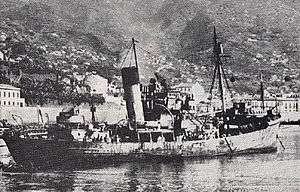HMS Lady Shirley
HMS Lady Shirley (T464), also known as HMT Lady Shirley,[1] was a fishing trawler requisitioned by the Royal Navy in 1940 and converted for anti-submarine warfare duties.[2] She sank U-111 on 4 October 1941, capturing 44 of her crew. Lady Shirley was sunk herself on 11 December 1941, by a single torpedo from U-374
 HMS Lady Shirley (ASW trawler) | |
| History | |
|---|---|
| Name: | HMS Lady Shirley |
| Operator: | Royal Navy |
| Builder: | |
| Yard number: | 615 |
| Launched: | 25 February 1937 |
| Completed: | 19 April 1937 |
| Acquired: | 1940 |
| Commissioned: | February 1941 |
| Fate: | Sunk on 11 December 1941 by torpedo from U374 during World War II (Straits of Gibraltar 35.59N, 05.17W) |
| General characteristics | |
| Class and type: | Anti-submarine trawler |
| Displacement: | 472 tonnes |
| Length: | 163.5 ft (49.8 m) |
| Beam: | 27.2 ft (8.3 m) |
| Propulsion: | 120 hp (89 kW) |
| Speed: | 12 knots (22 km/h; 14 mph) |
| Complement: | 33 |
| Sensors and processing systems: | ASDIC anti-submarine dome[1] |
| Armament: |
|
Description
Lady Shirley was a fishing trawler of 472 tons displacement based at Hull. She was built at Beverley in the UK by Cook, Welton & Gemmell and launched in 1937. She was 164 feet (50.0 m) long and 27 feet (8.2 m) in the beam. She had a 120 horsepower (89 kW) engine giving a top speed of 12 knots (22 km/h).[1]
Service record
She was pressed into service by the Royal Navy in 1940 and converted into an anti-submarine trawler. Conversion included fitting an ASDIC anti-submarine dome, a 4-inch naval gun and depth charges. She had a complement of 33. Lady Shirley went into service in January 1941 and served with the 31st Anti-Submarine Group based at Gibraltar. She was under the command of Lieutenant-Commander Arthur Henry Callaway.[1]
Sinking of U-111
On 4 October 1941, while searching for the damaged Silverbelle, Lady Shirley encountered German submarine U-111 engaged in a similar mission south-west of Tenerife, at position 27°15′N 20°27′W.[2] Mistaking the trawler for the damaged freighter (though Lady Shirley was small, the U-boat skipper thought she was far away) the U-boat was caught at periscope depth when Lady Shirley closed, and was depth charged. Forced to the surface, U-111 was engaged with gunfire until she was abandoned and sunk.[3] Of the U-boat crew of 52, eight were killed, including her commander, Wilhelm Kleinschmidt; 44 survived. Lady Shirley had one crew member killed and several injured in the battle.[1] This was the first time that prisoners of war (POWs) were captured from a U-boat operating in the South Atlantic. German survivors claimed that U-111 was the first U-boat to be lost of those operating in that area.[4]
Loss
On 11 December 1941, a torpedo from U-374 hit Lady Shirley, sinking her in the Straits of Gibraltar at position 35°59′N 5°17′W. All 33 crew were lost with their ship.[1][2]
References
- "Lady Shirley H464". Hull Trawler. Archived from the original on 31 May 2014. Retrieved 26 June 2013.
- Helgason, Guðmundur. "HMS Lady Shirley". German U-boats of WWII - uboat.net. Retrieved 26 June 2013.
- Clay Blair, Hitler’s U-Boat War Vol I (1996) ISBN 0-304-35260-8 pp. 385-6
- "U-111 – Interrogation of Survivors". U-boat Archive. Archived from the original on 10 July 2010. Retrieved 26 June 2013.
External links
- U 111 versus Lady Shirley (in Spanish)